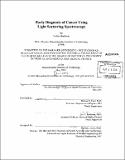| dc.contributor.advisor | Michael S. Feld and Lev T. Perelman. | en_US |
| dc.contributor.author | Backman, Vadim, 1973- | en_US |
| dc.contributor.other | Harvard University--MIT Division of Health Sciences and Technology. | en_US |
| dc.date.accessioned | 2006-03-24T18:00:38Z | |
| dc.date.available | 2006-03-24T18:00:38Z | |
| dc.date.copyright | 2001 | en_US |
| dc.date.issued | 2001 | en_US |
| dc.identifier.uri | http://hdl.handle.net/1721.1/29892 | |
| dc.description | Thesis (Ph. D.)--Harvard--Massachusetts Institute of Technology Division of Health Sciences and Technology, 2001. | en_US |
| dc.description | Includes bibliographical references. | en_US |
| dc.description.abstract | This thesis presents a novel optical technique, light scattering spectroscopy (LSS), developed for quantitative characterization of tissue morphology as well as in vivo detection and diagnosis of the diseases associated with alteration of normal tissue structure such as precancerous and early cancerous transformations in various epithelia. LSS employs a wavelength dependent component of light scattered by epithelial cells to obtain information about subcellular structures, such as cell nuclei. Since nuclear atypia is one of the hallmarks of precancerous and cancerous changes in most human tissues, the technique has the potential to provide a broadly applicable means of detecting epithelial precancerous lesions and noninvasive cancers in various organs, which can be optically accessed either directly or by means of optical fibers. We have developed several types of LSS instrumentation including 1) endoscopically compatible LSS-based fiber-optic system; | en_US |
| dc.description.abstract | (cont.) 2) LSS-based imaging instrumentation, which allows mapping quantitative parameters characterizing nuclear properties over wide, several cm2, areas of epithelial lining; and 3) scattering angle sensitive LSS instrumentation (a/LSS), which enables to study the internal structure of cells and their organelles, i.e. nuclei, on a submicron scale. Multipatient clinical studies conducted to test the diagnostic potential of LSS in five organs (esophagus, colon, bladder, cervix and oral cavity) have shown the generality and efficacy of the technique and indicated that LSS may become an important tool for early cancer detection as well as better biological understanding of the disease. | en_US |
| dc.description.statementofresponsibility | by Vadim Backman. | en_US |
| dc.format.extent | 256 leaves | en_US |
| dc.format.extent | 13741957 bytes | |
| dc.format.extent | 13776084 bytes | |
| dc.format.mimetype | application/pdf | |
| dc.format.mimetype | application/pdf | |
| dc.language.iso | eng | en_US |
| dc.publisher | Massachusetts Institute of Technology | en_US |
| dc.rights | M.I.T. theses are protected by copyright. They may be viewed from this source for any purpose, but reproduction or distribution in any format is prohibited without written permission. See provided URL for inquiries about permission. | en_US |
| dc.rights.uri | http://dspace.mit.edu/handle/1721.1/7582 | |
| dc.subject | Harvard University--MIT Division of Health Sciences and Technology. | en_US |
| dc.title | Early diagnosis of cancer using light scattering spectroscopy | en_US |
| dc.title.alternative | Early diagnosis of cancer using LSS | en_US |
| dc.type | Thesis | en_US |
| dc.description.degree | Ph.D. | en_US |
| dc.contributor.department | Harvard University--MIT Division of Health Sciences and Technology | |
| dc.identifier.oclc | 49545131 | en_US |
